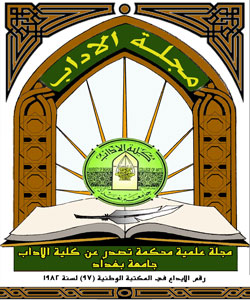The Use of Persuasive Appeals in Iraqi Covid-19 Selected News Reports
DOI:
https://doi.org/10.31973/aj.v3i144.4078الكلمات المفتاحية:
Persuasive Appeals، Covid-19، Ethos، Logos، Pathos، Rhetoricالملخص
In 2020, Covid-19 was the primary subject of discussion in the international media. Numerous news articles have been written about it, making it worthy for scholars and researchers to investigate in order to elucidate the linguistic characteristics that are used in such news. Accordingly, this study aims at presenting the theoretical aspects of persuasion and rhetoric. In addition, it demonstrates Lucas’ (2009) three persuasive appeals – ethos, logos, and pathos – as well as identifies and reveals their use and efficiency in Iraqi Covid-19 news articles published by Almada Newspaper and BAGHDADTODAY.NEWS. The findings of the present study suggest that the three rhetorical appeals are employed differently in the two types of data. More importantly, the three appeals are much more effective in the English data than in the Arabic data.
التنزيلات
المراجع
Bednarek, M. & Caple, H. (2012). News Discourse. Continuum International Publishing Group.
Herrick, J. (2018). The History and Theory of Rhetoric: An Introduction. Pearson Education.
Ilie, C. (2009). Rhetoric, Classical. O¨ rebro University.
Kennedy, G. (1991). A NEW HISTORY OF CLASSICAL RHETORIC. Princeton University Press.
Larrazabal, J., M. & Korta, K. (2002). Pragmatics and Rhetoric for Discourse Analysis: Some Conceptual Remarks. The University of the Basque Country.
Lucas, S. E. (2009). The Art of Public Speaking (10th ed.). The McGraw-Hill Companies.
Piazza, F. (2013). Rhetoric and Pragmatics: Suggestions for a Fruitful Dialogue. Springer International Publishing.
Ramage, J., D., Bean, J., C. & Johanson, J. (2016). Writing Arguments A Rhetoric with Readings. Pearson Education, Inc.
Talbot, M. (2007). Media Discourse Representation and Interaction. Edinburgh University Press.
Tavakoli, H. (2012). A Dictionary of Research Methodology and Statistics in Applied Linguistics. RAHNAMA PRESS.
Tuchman, G. (1972). THE TECHNOLOGY OF OBJECTIVITY: Doing “Objective” TV News Film. Sage Publications, Inc.
Van Dijk, T., A. (1988). News as Discourse. University of Amsterdam
التنزيلات
منشور
إصدار
القسم
الرخصة

هذا العمل مرخص بموجب Creative Commons Attribution 4.0 International License.
:حقوق الطبع والنشر والترخيص
بالنسبة لجميع البحوث المنشورة في مجلة الآداب، يحتفظ الباحثون بحقوق النشر. يتم ترخيص البحوث بموجب ترخيص Creative Commons CC BY 4.0 المفتوح ، مما يعني أنه يجوز لأي شخص تنزيل البحث وقراءته مجانًا. بالإضافة إلى ذلك ، يجوز إعادة استخدام البحث واقتباسه شريطة أن يتم الاستشهاد المصدر المنشور الأصلي. تتيح هذه الشروط الاستخدام الأقصى لعمل الباحث وعرضه.
:إعادة إنتاج البحوث المنشورة من الناشرين الآخرين
من الضروري للغاية أن يحصل الباحثون على إذن لإعادة إنتاج أي بحث منشورة (أشكال أو مخططات أو جداول أو أي مقتطفات من نص) لا يدخل في نطاق الملكية العامة أو لا يملكون حقوق نشرها. يجب أن يطلب الباحثون إذنًا من مؤلف حقوق النشر (عادة ما يكون الناشر).
يطلب الإذن في الحالات التالية:
بحوثك الخاصة المنشورة من قِبل ناشرين آخرين ولم تحتفظ بحقوق النشر الخاصة بها.
مقتطفات كبيرة من بحوث أي شخص أو سلسلة من البحوث المنشورة.
استخدم الجداول والرسوم البيانية والمخططات والمخططات والأعمال الفنية إذا لم يتم التعديل عليها.
الصور الفوتوغرافية التي لا تملك حقوق لنشرها.
لا يطلب الإذن في الحالات التالية:
إعادة بناء الجدول الخاص بك مع البيانات المنشورة بالفعل في مكان آخر. يرجى ملاحظة أنه في هذه الحالة يجب عليك ذكر مصدر البيانات في شكل "بيانات من ..." أو "مقتبس من ...".
تعتبر عروض الأسعار القصيرة معقولة الاستخدام العادل ، وبالتالي لا تتطلب إذنًا.
الرسوم البيانية ، الرسوم البيانية ، المخططات ، الأعمال الفنية التي أعاد الباحث رسمها بالكامل والتي تم تغييرها بشكل ملحوظ إلى درجة لا تتطلب الاعتراف.
الحصول على إذن
لتجنب التأخير غير الضروري في عملية النشر ، يجب أن تبدأ في الحصول على أذونات في أقرب وقت ممكن. لا يمكن لمجلة الآداب نشر بحث مقتبس من منشورات أخرى دون إذن.
قد يمنحك مالك حقوق الطبع والنشر تعليمات بشأن شكل الإقرار الواجب اتباعه لتوثيق عمله ؛ بخلاف ذلك ، اتبع النمط: "مستنسخ بإذن من [المؤلف] ، [كتاب / المجلة] ؛ نشره [الناشر] ، [السنة]." في نهاية شرح الجدول ، الشكل أو المخطط.
.jpg)























